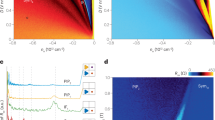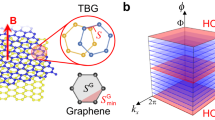Abstract
We present a mathematical derivation of some of the most important physical quantities arising in topological bilayer systems with permutation twist defects as introduced by Barkeshli et al. (Phys Rev B 87:045130_1-23, 2013). A crucial tool is the theory of permutation equivariant modular functors developed by Barmeier et al. (Int Math Res Notices 2010:3067–3100, 2010; Transform Groups 16:287–337, 2011).
Similar content being viewed by others
References
Bantay P.: Characters and modular properties of permutation orbifolds. Phys. Lett. B 419, 175–178 (1998)
Barkeshli, M., Jian, C.M., Qi, X.-L.: Twist defects and projective non-Abelian braiding statistics. Phys. Rev. B 87, 045130_1–045130_23 (2013). arXiv:1208.4834
Barkeshli, M., Jian, C.M., Qi, X.-L.: Classification of topological defects in abelian topological states. Phys. Rev. B 88, 241103(R)_1–241103(R)_5 (2013). arXiv:1304.7579
Barkeshli, M., Jian, C.M., Qi, X.-L.: Theory of defects in Abelian topological states. Phys. Rev. B 88, 235103_1–235103_21 (2013). arXiv:1305.7203
Barkeshli, M., Qi, X.-L.: Topological nematic states and non-abelian lattice dislocations. Phys. Rev. X 2, 031013_1–031013_11 (2012). arXiv:1112.3311
Barkeshli, M., Wen, X.-G.: \({U(1)\times U(1) \rtimes Z_2}\) Chern–Simons theory and Z 4 parafermion fractional quantum Hall states. Phys. Rev. B 81, 045323_1–045323_18 (2010).
Barmeier, T.: Permutation modular invariants from modular functors. Preprint arXiv:1006.3938
Barmeier T., Schweigert C.: A geometric construction for permutation equivariant categories from modular functors. Transform. Groups 16, 287–337 (2011) arXiv:1004.1825
Barmeier T., Fuchs J., Runkel I., Schweigert C.: Module categories for permutation modular invariants. Int. Math. Res. Notices 2010, 3067–3100 (2010) arXiv:0812.0986
Birke L., Fuchs J., Schweigert C.: Symmetry breaking boundary conditions and WZW orbifolds. Adv. Theor. Math. Phys. 3, 671–624 (1999) hep-th/9905038
Borisov L.A., Halpern M.B., Schweigert C.: Systematic approach to cyclic orbifolds. Int. J. Mod. Phys. A 13, 125–168 (1998) hep-th/9701061
Buerschaper, O., Mombelli, J.M., Christandl, M., Aguado, M.: A hierarchy of topological tensor network states. J. Math. Phys. 54, 012201_1–012201_46 (2013). arXiv:1007.5283
Davydov A.A., Nikshych D., Ostrik V.: On the structure of the Witt group of braided fusion categories. Selecta Mathematica 19, 237–269 (2013) arXiv:1109.5558
Etingof P.I., Nikshych D., Ostrik V., Meir E.: Fusion categories and homotopy theory. Quantum Topol. 1, 209–273 (2010) arXiv:0909.3140
Freedman, M., Hastings, M.B., Nayak, C., Qi, X.-L., Walker, K., Wang, Z.: Projective ribbon permutation statistics: a remnant of non-abelian braiding in higher dimensions. Phys. Rev. B 83, 115132_1–115132_35 (2011). arXiv:1005.0583
Freedman, M., Nayak, C., Walker, K.: Towards universal topological quantum computation in the \({\nu=5/2}\) fractional quantum Hall state. Phys. Rev. B 73, 245307_1–245307_21 (2006). cond-mat/0512066
Fröhlich J., Fuchs J., Runkel I., Schweigert C.: Correspondences of ribbon categories. Adv. Math. 199, 192–329 (2006) math.CT/0309465
Fröhlich, J., Fuchs, J., Runkel, I., Schweigert, C.: Defect lines, dualities, and generalised orbifolds. In: Exner, P. (ed.) XVI International Congress on Mathematical Physics, pp. 608–613. World Scientific, Singapore (2010). arXiv:0909.5013
Fuchs, J., Schweigert, C., Stigner, C.: From non-semisimple Hopf algebras to correlation functions for logarithmic CFT. J. Phys. A 46, 494008_1–494008_40 (2013). arXiv:1302.4683
Fuchs J., Schweigert C., Valentino A.: Bicategories for boundary conditions and for surface defects in 3-d TFT. Commun. Math. Phys. 321, 543–575 (2013) arXiv:1203.4568
Fuchs, J., Schweigert, C., Valentino, A.: A geometric approach to boundaries and surface defects in Dijkgraaf–Witten theories. Commun. Math. Phys. doi:10.1007/s00220-014-2067-0
Kapustin A., Saulina N.: Topological boundary conditions in abelian Chern–Simons theory. Nucl. Phys. B 845, 393–435 (2011) arXiv:1008.0654
Kirillov A.A.: Modular categories and orbifold models. Commun. Math. Phys. 229, 309–335 (2002) math.QA/0104242
Kirillov, A.A.: On G-equivariant modular categories. Preprint math.QA/0401119
Kirillov A.A., Ostrik V.: On a q-analog of McKay correspondence and the ADE classification of \({\widehat {\mathfrak{sl}}(2)}\) conformal field theories. Adv. Math. 171, 183–227 (2002) math.QA/0101219
Kitaev A., Kong L.: Models for gapped boundaries and domain walls. Commun. Math. Phys. 313, 351–373 (2012) arXiv:1104.5047
Kong L., Runkel I.: Morita classes of algebras in modular tensor categories. Adv. Math. 219, 1548–1576 (2008) arXiv:0708.1897
Morton, J.C.: Cohomological twisting of 2-linearization and extended TQFT. J. Homotopy Relat. Struct. doi:10.1007/s40062-013-0047-2
Müger M.: From subfactors to categories and topology I. Frobenius algebras in and Morita equivalence of tensor categories. J. Pure Appl. Alg. 180, 81–157 (2003) math.CT/0111204
Müger M.: Conformal orbifold theories and braided crossed G-categories. Commun. Math. Phys. 260, 727–762 (2005) math.QA/0403322 [ibid. 260 (2005) 763, Erratum]
Ostrik V.: Module categories, weak Hopf algebras and modular invariants. Transform. Groups 8, 177–206 (2003) math.QA/0111139
Ostrik V.: Module categories over the Drinfeld double of a finite group. Int. Math. Res. Notices No. 27, 1507–1520 (2003) math.QA/0202130
Turaev V.G.: Homotopy Quantum Field Theory. European Mathematical Society, Zürich (2010)
Van Oystaeyen F., Zhang Y.H.: The Brauer group of a braided monoidal category. J. Algebra 202, 96–128 (1998)
Author information
Authors and Affiliations
Corresponding author
Rights and permissions
About this article
Cite this article
Fuchs, J., Schweigert, C. A Note on Permutation Twist Defects in Topological Bilayer Phases. Lett Math Phys 104, 1385–1405 (2014). https://doi.org/10.1007/s11005-014-0719-9
Received:
Revised:
Accepted:
Published:
Issue Date:
DOI: https://doi.org/10.1007/s11005-014-0719-9




